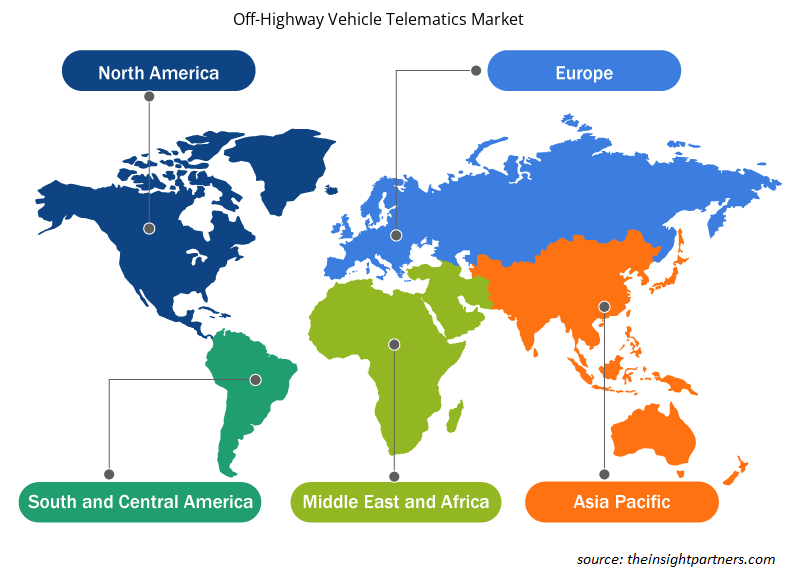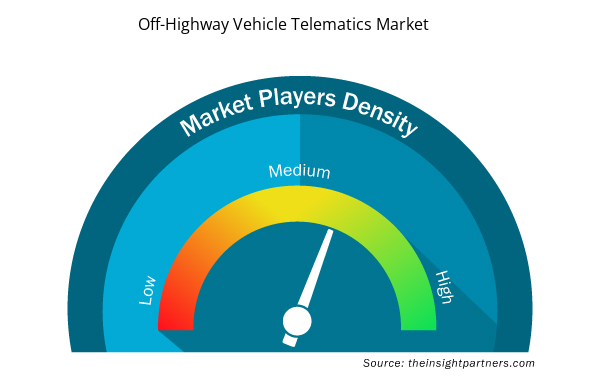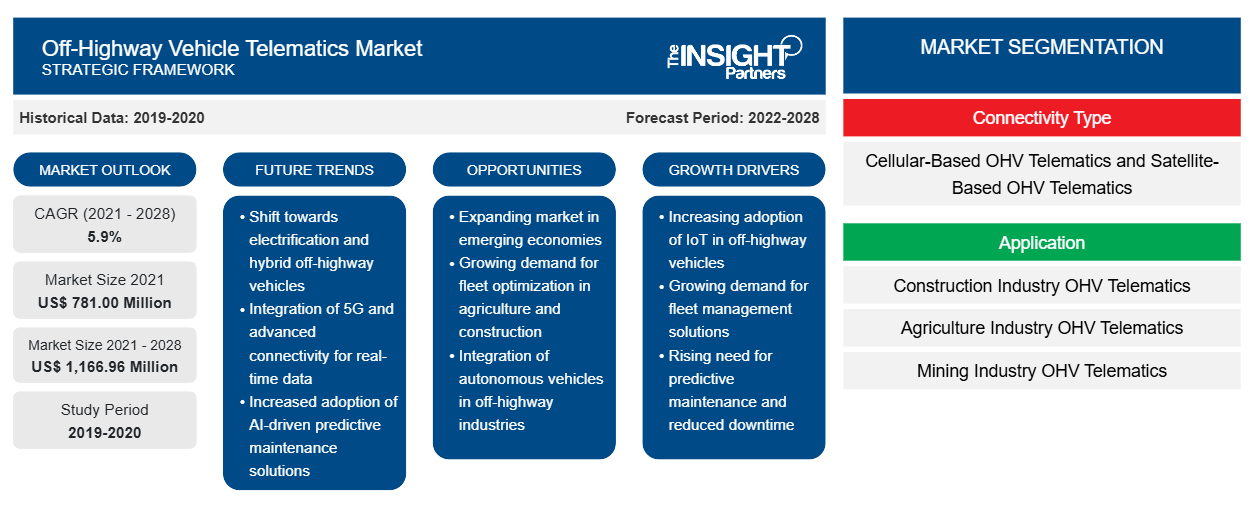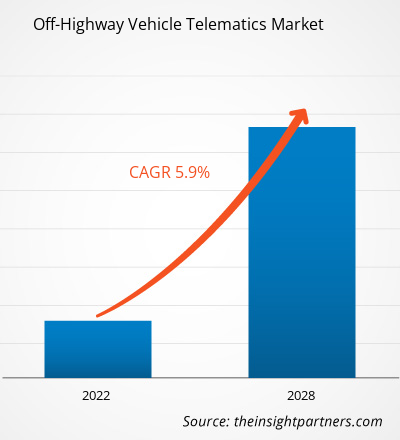2021 年非公路车辆远程信息处理市场价值为 7.81 亿美元,预计到 2028 年将达到 11.6696 亿美元;预计在 2021 年至 2028 年的预测期内复合年增长率为 5.9%。
由于技术的进步,远程信息处理业务发展迅速。为了保持竞争优势,必须研究一些即将出现的新趋势:
- 迅捷互联网络:升级到4G和5G网络,在带宽、更快的数据上传和反馈下载方面提供全新的体验,从而带来更多的实时数据集、实时驾驶员安全、车队维护和车队效率。
- 云支持:传感器连接到车辆的不同子系统。这些系统不断交换大量数据。轮胎压力监测、视频捕捉和温度监测传感器只是其中几个例子。云技术的进步使得存储、处理和成功使用大量数据成为可能。
- 小型企业的采用:远程信息处理已不仅仅是服务提供商和小型车队所有者的趋势。许多初创公司提供低成本但有效的远程信息处理解决方案,这些解决方案可以在当地市场上为小型车队所有者找到。
- 直接数据访问和直观的仪表板:用户可以直接访问数据以进行决策。个人司机、调度经理、中央车队代理或当地办事处以及特许经营商都可以从这些数据中受益。所有利益相关者都获得了基于角色的个性化仪表板,这些仪表板具有有限的访问权限,他们可以根据自己的特定服务需求、交付或到达时间、处理限制和其他因素做出明智的实时决策。这也有助于车队管理企业维护基于行为的驾驶员记分卡,并具有法律意义。许多公司还与航运和运输行业交换数据,以改善码头调度。这有助于有效规划,并让司机更快乐、更高效。
因此,非公路车辆远程信息处理技术的不断进步将推动非公路车辆远程信息处理市场的增长
定制此报告以满足您的需求
您可以免费定制任何报告,包括本报告的部分内容、国家级分析、Excel 数据包,以及为初创企业和大学提供优惠和折扣
- 获取此报告的关键市场趋势。这个免费样品将包括数据分析,从市场趋势到估计和预测。
建筑行业的快速数字化转型促使人们采用新技术,为非公路车辆远程信息处理市场提供了新的前景。建筑设备远程信息处理可帮助公司跟踪其设备的位置和性能,监控资产利用率,并验证资产是否得到有效利用。如果设备利用率不足,则可能会将其转移到需要它的其他位置。这就是建筑设备远程信息处理如何提高整体效率,进而对非公路远程信息处理市场产生积极影响。
此外,私营和公共部门建筑活动的增加可能会促进市场增长。印度、菲律宾、阿联酋、沙特阿拉伯、埃及、尼日利亚和美国等国家正在实施或计划实施多个基础设施相关项目。例如,印度政府在 2014-2015 年联邦预算中为本财年拨款 11.2 亿美元作为“一百个智能城市”计划的一部分。此外,政府计划在未来 20 年内向全国各种城市和基础设施项目投资 6500 亿美元,这反过来将支持非公路车辆远程信息处理市场的增长。中东地区的各种基础设施项目正在进行中,包括吉达经济城(沙特阿拉伯)、马斯达尔城(阿联酋)和迪拜乐园(阿联酋)。基础设施项目的快速增长可能会增加对建筑设备的需求。
COVID-19 疫情对北美非公路车辆远程信息处理市场的影响
由于政府出台了有利于促进创新和加强基础设施能力的政策,北美是新技术开发和采用方面的领先地区之一。因此,任何对工业部门增长的不利影响都会阻碍该地区的经济增长。目前,美国是受COVID-19疫情影响最大的国家。非公路车辆远程信息处理市场对汽车公司和汽车零部件制造商等制造业参与者的依赖,最近由于COVID-19疫情导致制造部门暂停,这一依赖尤为明显。甚至在COVID-19疫情爆发之前,汽车行业就面临着电动汽车、无人驾驶汽车、自动化工厂和拼车等挑战。由于严格的旅行限制、国际制造业关闭、汽车销量下降以及大规模裁员,汽车行业正遭受重大挫折。一旦行业恢复正常运营条件,对非公路车辆远程信息处理的总体需求可能会增加。由于汽车需求的增长、政府的优惠政策以及北美国家对先进技术的投资不断增加,北美对非公路车辆远程信息处理的需求很大。
非公路车辆远程信息处理市场洞察
物联网融合度不断提升
微机电系统、互联网和无线技术共同构成了物联网 (IoT)。车队所有者可以利用物联网远程监控车辆速度、轮胎气压、燃油使用情况和驾驶员行为,从而进一步提高车辆和驾驶员的效率。远程信息处理系统开发人员可以使用这项技术创建远程信息处理解决方案,以满足运营成本较高的采矿、农业和建筑行业的特定需求。服务提供商和车队运营商可以通过结合物联网和车队管理技术来采用预测分析。这为实现主动管理提供了环境,并在几个关键运营领域获得了竞争优势。空调等面向服务的产品中的物联网传感器只能在需要时而不是定期通知服务电话。基于条件的监控可以降低服务成本,同时提高准确性和客户服务。任何车队最大的开支之一就是燃料。如果将物联网传感器集成到远程信息处理系统中,车队经理就可以近乎实时地查看车辆的燃油使用情况和支出。这样,管理人员就能了解哪些人需要接受有效驾驶行为的培训,并追踪违规运营支出和驾驶模式,例如怠速,这会浪费汽油。此外,所有车队都高度重视安全。随着超速、急刹车和鲁莽驾驶事件的增多,车队管理人员可以利用驾驶员指导和安全教育来解决不良驾驶行为。因此,物联网的日益融合可以开辟新的商业可能性。
基于连接类型的市场洞察
根据连接类型,非公路车辆远程信息处理市场细分为基于蜂窝的 OHV 远程信息处理和基于卫星的 OHV 远程信息处理。2020 年,基于蜂窝的 OHV 远程信息处理领域以 77.6% 的份额领先于非公路车辆远程信息处理市场。
基于应用的市场洞察
根据应用,非公路车辆远程信息处理市场可细分为建筑行业 OHV 远程信息处理、农业行业 OHV 远程信息处理、采矿业 OHV 远程信息处理等。2020 年,建筑行业 OHV 远程信息处理领域以 64.3% 的份额领先于非公路车辆远程信息处理市场。
非公路车辆远程信息处理市场区域洞察
Insight Partners 的分析师已详尽解释了预测期内影响非公路车辆远程信息处理市场的区域趋势和因素。本节还讨论了非公路车辆远程信息处理市场在北美、欧洲、亚太地区、中东和非洲以及南美和中美洲的细分市场和地理位置。

- 获取非公路车辆远程信息处理市场的区域特定数据
非公路车辆远程信息处理市场报告范围
| 报告属性 | 细节 |
|---|---|
| 2021 年市场规模 | 7.81亿美元 |
| 2028 年市场规模 | 11.6696亿美元 |
| 全球复合年增长率(2021 - 2028) | 5.9% |
| 史料 | 2019-2020 |
| 预测期 | 2022-2028 |
| 涵盖的领域 | 按连接类型
|
| 覆盖地区和国家 | 北美
|
| 市场领导者和主要公司简介 |
|
市场参与者密度:了解其对商业动态的影响
非公路车辆远程信息处理市场正在快速增长,这得益于最终用户需求的不断增长,这些需求源于消费者偏好的不断变化、技术进步以及对产品优势的认识不断提高等因素。随着需求的增加,企业正在扩大其产品范围,进行创新以满足消费者的需求,并利用新兴趋势,从而进一步推动市场增长。
市场参与者密度是指在特定市场或行业内运营的企业或公司的分布情况。它表明在给定市场空间中,相对于其规模或总市场价值,有多少竞争对手(市场参与者)存在。
在非公路车辆远程信息处理市场运营的主要公司有:
- 威克诺森
- Stoneridge 公司
- TTControl GmbH
- Omnitracs 有限责任公司
- ORBCOMM 公司
免责声明:上面列出的公司没有按照任何特定顺序排列。

- 了解非公路车辆远程信息处理市场的主要参与者概况
基于技术的市场洞察
根据技术,非公路车辆远程信息处理市场可细分为 LTE-M、NB-IoT、Sigfox 等。2020 年,LTE-M 以 82.3% 的份额领先于非公路车辆远程信息处理市场。
非公路车辆远程信息处理市场的参与者采用合并、收购和市场计划等策略来保持其在市场中的地位。以下列出了一些主要参与者的发展:
- 2022 年 1 月,Stoneridge 和 Valens 半导体建立合作伙伴关系,通过先进的连接和视觉解决方案开发拖拉机拖车安全,从而对非公路远程信息处理市场产生积极影响。
- 2020 年 8 月,HY-TTC 500 控制器系列获得道路使用认证。HY-TTC 500 由高端安全控制单元组成,旨在构建安全、集中的电子架构。TTControl 的产品 HY-TTC 500 控制器的认证已根据 ISO 26262 获得道路使用认证。
公司简介
- Omnitracs 有限责任公司
- 轨道交通通讯
- Stoneridge 公司
- Teletrac 导航仪
- TomTom 国际有限公司
- 轨道单元公司
- 威克诺森
- Zonar 系统公司
- TT控制有限公司
- ACTIA 集团
- 历史分析(2 年)、基准年、预测(7 年)及复合年增长率
- PEST 和 SWOT 分析
- 市场规模价值/数量 - 全球、区域、国家
- 行业和竞争格局
- Excel 数据集



Report Coverage
Revenue forecast, Company Analysis, Industry landscape, Growth factors, and Trends

Segment Covered
This text is related
to segments covered.

Regional Scope
North America, Europe, Asia Pacific, Middle East & Africa, South & Central America

Country Scope
This text is related
to country scope.
常见问题
Based on connectivity type, the off-highway vehicle telematics market is segmented into Cellular-Based OHV telematics, and Satellite-Based OHV telematics. The cellular-Based OHV telematics segment led the off-highway vehicle telematics market with a share of 77.6% in 2020.
Growth in construction industry and government policies to increase security and safety of off-highway vehicles are driving the growth of the off-highway vehicle telematics market.
The market opportunity lies in developing countries. Developing countries have become a hub of opportunity for various markets, including off-highway vehicle telematics market. The growing integration of the IoT can open up new commercial possibilities thus are presenting significant potential for the future growth of the off-highway vehicle telematics market players.
In 2020, North America led the market with a substantial revenue share, followed by Asia Pacific and Europe. North America is a prospective market for off-highway vehicle telematics developers.
The major companies in off-highway vehicle telematics includes Omnitracs, LLC; ORBCOMM; Stoneridge, Inc.; Teletrac Navman; TomTom International BV; Trackunit A/S; Wacker Neuson, Zonar Systems Inc.; TTCONTROL GMBH; and ACTIA Group.
Based on application, the off-highway vehicle telematics market can be segmented Construction Industry OHV telematics, Agriculture Industry OHV telematics, Mining Industry OHV telematics, and Others. The construction industry OHV telematics segment led the Off-Highway Vehicle Telematics market with a share of 64.3% in 2020.
Trends and growth analysis reports related to Automotive and Transportation : READ MORE..
The List of Companies - Off-Highway Vehicle Telematics Market
- Wacker Neuson SE
- Stoneridge, Inc.
- TTControl GmbH
- Omnitracs, LLC
- ORBCOMM Inc.
- Trackunit A/S
- TomTom Telematics BV
- Zonar Systems Inc.
- Teletrac Navman
- ACTIA Group
The Insight Partners performs research in 4 major stages: Data Collection & Secondary Research, Primary Research, Data Analysis and Data Triangulation & Final Review.
- Data Collection and Secondary Research:
As a market research and consulting firm operating from a decade, we have published and advised several client across the globe. First step for any study will start with an assessment of currently available data and insights from existing reports. Further, historical and current market information is collected from Investor Presentations, Annual Reports, SEC Filings, etc., and other information related to company’s performance and market positioning are gathered from Paid Databases (Factiva, Hoovers, and Reuters) and various other publications available in public domain.
Several associations trade associates, technical forums, institutes, societies and organization are accessed to gain technical as well as market related insights through their publications such as research papers, blogs and press releases related to the studies are referred to get cues about the market. Further, white papers, journals, magazines, and other news articles published in last 3 years are scrutinized and analyzed to understand the current market trends.
- Primary Research:
The primarily interview analysis comprise of data obtained from industry participants interview and answers to survey questions gathered by in-house primary team.
For primary research, interviews are conducted with industry experts/CEOs/Marketing Managers/VPs/Subject Matter Experts from both demand and supply side to get a 360-degree view of the market. The primary team conducts several interviews based on the complexity of the markets to understand the various market trends and dynamics which makes research more credible and precise.
A typical research interview fulfils the following functions:
- Provides first-hand information on the market size, market trends, growth trends, competitive landscape, and outlook
- Validates and strengthens in-house secondary research findings
- Develops the analysis team’s expertise and market understanding
Primary research involves email interactions and telephone interviews for each market, category, segment, and sub-segment across geographies. The participants who typically take part in such a process include, but are not limited to:
- Industry participants: VPs, business development managers, market intelligence managers and national sales managers
- Outside experts: Valuation experts, research analysts and key opinion leaders specializing in the electronics and semiconductor industry.
Below is the breakup of our primary respondents by company, designation, and region:

Once we receive the confirmation from primary research sources or primary respondents, we finalize the base year market estimation and forecast the data as per the macroeconomic and microeconomic factors assessed during data collection.
- Data Analysis:
Once data is validated through both secondary as well as primary respondents, we finalize the market estimations by hypothesis formulation and factor analysis at regional and country level.
- Macro-Economic Factor Analysis:
We analyse macroeconomic indicators such the gross domestic product (GDP), increase in the demand for goods and services across industries, technological advancement, regional economic growth, governmental policies, the influence of COVID-19, PEST analysis, and other aspects. This analysis aids in setting benchmarks for various nations/regions and approximating market splits. Additionally, the general trend of the aforementioned components aid in determining the market's development possibilities.
- Country Level Data:
Various factors that are especially aligned to the country are taken into account to determine the market size for a certain area and country, including the presence of vendors, such as headquarters and offices, the country's GDP, demand patterns, and industry growth. To comprehend the market dynamics for the nation, a number of growth variables, inhibitors, application areas, and current market trends are researched. The aforementioned elements aid in determining the country's overall market's growth potential.
- Company Profile:
The “Table of Contents” is formulated by listing and analyzing more than 25 - 30 companies operating in the market ecosystem across geographies. However, we profile only 10 companies as a standard practice in our syndicate reports. These 10 companies comprise leading, emerging, and regional players. Nonetheless, our analysis is not restricted to the 10 listed companies, we also analyze other companies present in the market to develop a holistic view and understand the prevailing trends. The “Company Profiles” section in the report covers key facts, business description, products & services, financial information, SWOT analysis, and key developments. The financial information presented is extracted from the annual reports and official documents of the publicly listed companies. Upon collecting the information for the sections of respective companies, we verify them via various primary sources and then compile the data in respective company profiles. The company level information helps us in deriving the base number as well as in forecasting the market size.
- Developing Base Number:
Aggregation of sales statistics (2020-2022) and macro-economic factor, and other secondary and primary research insights are utilized to arrive at base number and related market shares for 2022. The data gaps are identified in this step and relevant market data is analyzed, collected from paid primary interviews or databases. On finalizing the base year market size, forecasts are developed on the basis of macro-economic, industry and market growth factors and company level analysis.
- Data Triangulation and Final Review:
The market findings and base year market size calculations are validated from supply as well as demand side. Demand side validations are based on macro-economic factor analysis and benchmarks for respective regions and countries. In case of supply side validations, revenues of major companies are estimated (in case not available) based on industry benchmark, approximate number of employees, product portfolio, and primary interviews revenues are gathered. Further revenue from target product/service segment is assessed to avoid overshooting of market statistics. In case of heavy deviations between supply and demand side values, all thes steps are repeated to achieve synchronization.
We follow an iterative model, wherein we share our research findings with Subject Matter Experts (SME’s) and Key Opinion Leaders (KOLs) until consensus view of the market is not formulated – this model negates any drastic deviation in the opinions of experts. Only validated and universally acceptable research findings are quoted in our reports.
We have important check points that we use to validate our research findings – which we call – data triangulation, where we validate the information, we generate from secondary sources with primary interviews and then we re-validate with our internal data bases and Subject matter experts. This comprehensive model enables us to deliver high quality, reliable data in shortest possible time.


 获取此报告的免费样本
获取此报告的免费样本